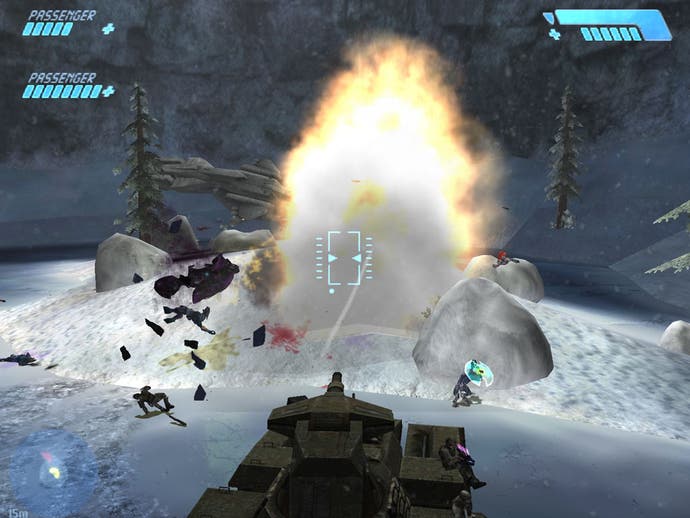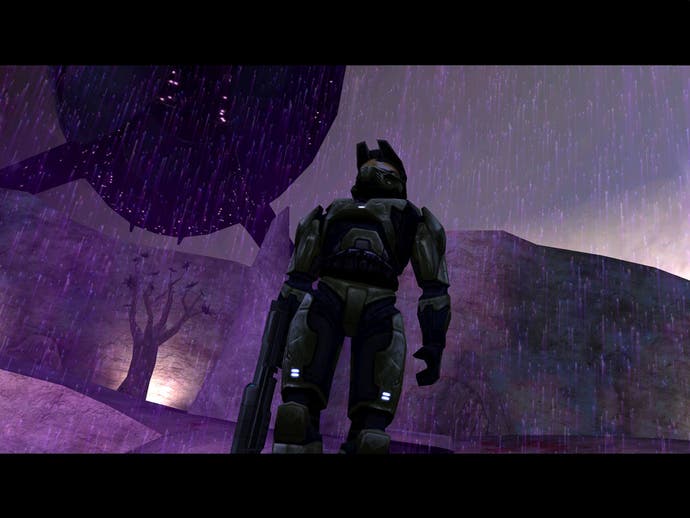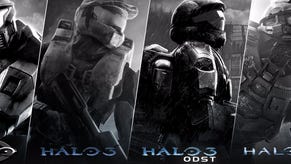Halo: Combat Evolved
It's finally here...
Rob's Second Opinion
Before I launch into this, let me be clear about something; I agree completely with what Kristan has said about the single-player aspects of Halo. It's good - right up there with a lot of the best PC first person shooters - but it's not ground-breaking, earth-shaking or indeed any other soil-displacing phrases. There's a great storyline in there, some excellent set pieces and it's an extremely polished example of the genre which every FPS fan really should play - but for the most part, Halo simply borrows the best ideas from other FPS games and implements them extremely well rather than inventing something genuinely new.
As such, there's no doubt in my mind that you ought to play Halo single-player - either on your PC, or, if you don't have a PC capable of dealing with its rather demanding system requirements, on an Xbox. That much is certain, and given that the port of the single-player game to the PC is simply very competent and unembellished, there's little point in reiterating Kristan's thoughts here any further. It's a good port of a very good game. Go play.
Play the World

What we're really interested in, though, is the multiplayer aspect of the PC game. Now here's something new - sixteen player Halo, over the Internet, with a host of new maps, weapons, vehicles and game types. When Halo was first shown to the world - long before Microsoft bought Bungie and made the game into an Xbox exclusive - this is what we all imagined; barrelling along in a Warthog with your team-mates firmly strapped in, while enemy and friendly fire zipped along overhead and the chaingun mounted on the back of the vehicle blared out a hot lead welcome to any aggressor foolish enough to come near. It's finally here; is the reality as good as the vivid imaginings?
Frankly, happily - yes, it is. Gearbox has worked wonders with the multiplayer aspect of Halo PC, taking an Xbox multiplayer model which worked extremely well in split-screen and System Link modes and adding the kind of content and features which are guaranteed to satisfy the more demanding PC multiplayer gamers. They've created a multiplayer game which combines some of the best aspects of other popular games such as Tribes, Battlefield 1942 and Unreal Tournament while retaining the personality and unique feel of Halo - a mouth-watering prospect for online gamers, particularly those growing sick of the endless diet of realism, realism and more realism which has been spawned by the success of Counter-Strike.
Kristan has already explained the basics of how the multiplayer game works, and the new additions which Gearbox has added to the game, so there's no point in re-inventing the wheel by listing all of that again. However, it's worth addressing some of the points raised in his comments - primarily, the sixteen-player limit on multiplayer. I confess that I was disappointed by this limitation at first as well - like many people, I had hoped for epic scale battles spread across kilometres of ground, with tens of players duking it out in style. Playing Halo PC for a while, however, has revealed that this simply isn't what the creators were trying to make - it's not that they've failed in the task of providing this experience; it's that they were never even trying to accomplish that.
The Great Outdoors

What Halo PC provides, instead, is an extremely competent and well-balanced small-scale multiplayer game - and yet at times, it's easy to forget how few other players there are on the map with you. Each map - even huge outdoor ones like Timberland, which has quickly become a personal favourite - is just the right size for the player limit, and even smaller matches, with eight to ten players, see fairly hectic action spread across the map. The inclusion of vehicles means that gameplay moves very fast and spreads across the entire map, so you'll never find yourself walking around aimlessly for minutes looking for someone to shoot at.
In actual combat, the balance of interesting weapons and well-implemented physics which made Halo multiplayer on the Xbox so addictive is still as evident as ever, and the stunts which can be performed (accidentally or on purpose) using a combination of vehicles and explosive weaponry make Halo into one of the single most fun multiplayer games we've ever played. The genius decision to make Warthogs indestructible is a key factor in the gameplay, as it eliminates the traditional queues for vehicles and makes stealing enemy vehicles and effectively controlling all the vehicles on a map into a valid tactic. Similarly the fact that you can only carry two weapons at a time radically differentiates the gameplay from the likes of Unreal Tournament, and effectively provides a built-in but very flexible class system to the game.
It's early days yet for Halo PC online, and it's yet to be seen how well the game will service more serious clan match style play; however, the potential for clan play is certainly there, given the appropriate server settings, and it's not hard to envisage some serious leagues and tournaments being focused around the CTF gametypes. It'll be interesting to see how it's received when it makes its "pro-gaming" (blech) debut at the CPL in Dallas, with 5v5 matches being the order of the day.
Balance in All Things

This isn't to say that Halo PC is a perfect multiplayer game by any means. It's superbly customisable, full of excellently balanced weapons and vehicles (a framework into which Gearbox's new weapons, the flamethrower and the fuel rod gun, fit perfectly, providing an excellent close-range melee weapon and a long-range artillery weapon respectively) and it's one of the most genuinely, honestly fun games we've played in ages. Playing this online with voice activated voice communications is a disaster - you end up with so much spontaneous laughter (and, we're ashamed to say as reserved European types, whooping) from the other players that actual communications hardly get a look-in.
However, the game does suffer from several flaws - the first and most pressing of which is the ludicrous system specs needed to run it correctly. Tweaking the settings appears to be the order of the day, but regardless, it's a bit of a shock to find a game which runs perfectly happily on an Xbox but gives poor frame-rates on a 2.4GHz machine with a top-end NVIDIA or ATI graphics card in it. This is a real shame, because it'll put a lot of people off playing - we can only hope that some of the engine problems can be ironed out in patches down the line.
The game also suffers badly when the action moves indoors. Halo is at its best in open spaces, with dramatic encounters on maps such as Death Island (which single-player veterans will recognise as a multiplayer version of The Silent Cartographer), Blood Gulch and Timberland being by far the best moments in the game. Indoor corridor-running maps, on the other hand, are downright poor; we wouldn't be surprised to see them removed from many server rotations altogether. At the end of the day, if you want to run through corridors, you play Quake or Unreal; if you want to fly off bumps in a speeding jeep and skid sideways through a couple of enemies, you play Halo.
We're also a little bit concerned that the lack of a Linux dedicated server for the game - a decision apparently taken because Microsoft published the game, and Microsoft likes to bury its head in the sand and pretend that Linux game servers don't exist - might reduce the level of support available for the game from big ISP game servers. Only time will tell, however, and if the game proves popular enough then it's likely that it'll get the support it deserves.
Halo, Goodbye
Ultimately, Halo is a very very difficult game to give a score to - so I'm going to cheat, and simply provide a score for the multiplayer element of the game, since that's what I've focused on, and because I believe that Kristan has already discussed the single-player element as much as is needed. Taking that into account - and bearing in mind that this game probably won't run shockingly well without major tweaking, because it's one of the most demanding games in terms of system specs that we've ever seen - the score below should tell you everything you need to know. With Doom III and Half-Life 2 now delayed to 2004, there's only one other real contender for the crown of being the top multiplayer FPS this Christmas; and unless Unreal Tournament 2004 can pull something fairly amazing out of the hat, we're pretty confident that Halo PC is that game.








